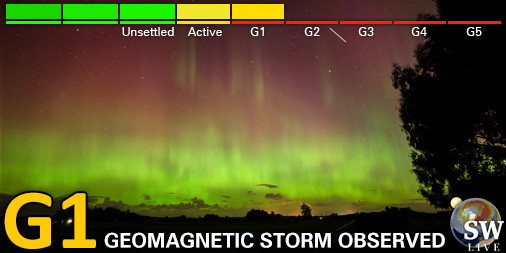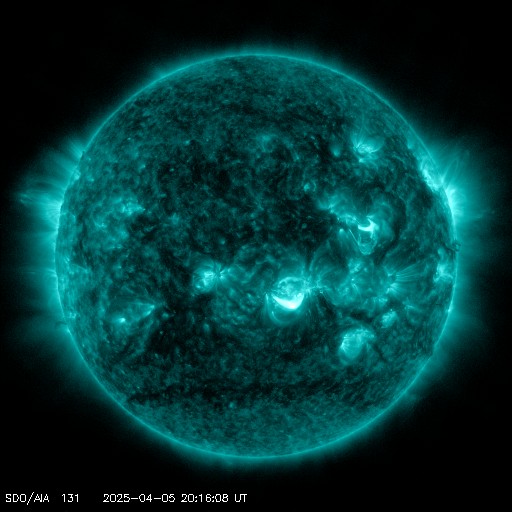Viewing archive of Tuesday, 6 November 2001
Geophysical report
Any mentioned solar flare in this report has a scaling factor applied by the Space Weather Prediction Center (SWPC). Because of the SWPC scaling factor, solar flares are reported as 42% smaller than for the science quality data. The scaling factor has been removed from our archived solar flare data to reflect the true physical units.
Solar and Geophysical Activity Summary 2001 Nov 06 0245 UTCPrepared by the NOAA © SWPC and processed by SpaceWeatherLive.com
Joint USAF/NOAA Solar and Geophysical Activity Summary
SGAS Number 310 Issued at 0245Z on 06 Nov 2001 This report is compiled from data received at SWO on 05 NovA. Energetic Events
Begin Max End Rgn Loc Xray Op 245MHz 10cm Sweep 0247 0250 0253 9687 S20E34 M1.7 Sf 29 0845 0854 0902 M1.2 0907 0915 0922 9684 N02W37 M2.1 1n 60 1509 1537 1619 M1.2 1627 1628 1716 9687 S19E24 Sf 500
B. Proton Events
The greater than 100 MeV proton event that
started on 04 November continued through out the period and flux
levels continued to climb, closing out the day at 116 pfu. The
greater than 10 MeV proton event also continued to escalate flux
levels, closing the period at 24,300 pfu. Both proton events
originated from the X1/3b flare from Region 9684, that occurred on
04/1620 UTC. Subsequent flares may have contributed to the continued
proton flux increase. A polar cap absorption event remains in
progress.
C. Geomagnetic Activity Summary
The geomagnetic field was at quiet
to active levels.
D. Stratwarm
None
E. Daily Indices: (real-time preliminary/estimated values)
10 cm 235 SSN 159 Afr/Ap 012/013 X-ray Background C3.3 Daily Proton Fluence (flux accumulation over 24 hrs) GT 1 MeV 9.3e+08 GT 10 MeV 5.3e+08 p/(cm2-ster-day) (GOES-8 satellite synchronous orbit W75 degrees) Daily Electron Fluence GT 2 MeV 1.20e+04 e/(cm2-ster-day) (GOES-8 satellite synchronous orbit W75 degrees) 3 Hour K-indices Boulder 0 0 2 2 4 4 4 3 Planetary 0 0 1 2 3 4 5 4
F. Comments
None
All times in UTC
Current data suggests there is a slight possibility for aurora to appear at the following high latitude regions in the near future
Gillam, MB, Yellowknife, NTLatest news
Latest forum messages
Incoming & Unnumbered Active Regions 1666Unspecified geomagnetic activity 2228A few (probably stupid) questions about Earth's magnetic field decay 4AR 4054 6AR4048 119
More topicsSupport SpaceWeatherLive.com!
A lot of people come to SpaceWeatherLive to follow the Sun's activity or if there is aurora to be seen, but with more traffic comes higher server costs. Consider a donation if you enjoy SpaceWeatherLive so we can keep the website online!

Latest alerts
02:00 UTC - Geomagnetic activity
Minor G1 geomagnetic storm (Kp5) Threshold Reached: 01:50 UTC
Saturday, 5 April 2025
20:30 UTC - Geomagnetic activity
Minor G1 geomagnetic storm (Kp5) Threshold Reached: 20:20 UTC
20:24 UTC - Solar flare
Moderate M1.05 flare
20:09 UTC - Radio Blackout
Minor R1 radio blackout in progress (≥M1 - current: M1.05)
10:00 UTC - Hemispheric Power Index
The OVATION model predicts the Hemispheric Power Index to reach 78GW at 10:32 UTC
Space weather facts
| Last X-flare | 2025/03/28 | X1.1 |
| Last M-flare | 2025/04/05 | M1.0 |
| Last geomagnetic storm | 2025/04/05 | Kp6- (G2) |
| Spotless days | |
|---|---|
| Last spotless day | 2022/06/08 |
| Monthly mean Sunspot Number | |
|---|---|
| March 2025 | 134.2 -20.4 |
| April 2025 | 150.4 +16.2 |
| Last 30 days | 131.6 -13.4 |





